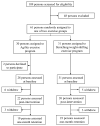Exercise leads to faster postural reflexes, improved balance and mobility, and fewer falls in older persons with chronic stroke
- PMID: 15743283
- PMCID: PMC3226796
- DOI: 10.1111/j.1532-5415.2005.53158.x
Exercise leads to faster postural reflexes, improved balance and mobility, and fewer falls in older persons with chronic stroke
Abstract
Objectives: To determine the effect of two different community-based group exercise programs on functional balance, mobility, postural reflexes, and falls in older adults with chronic stroke.
Design: A randomized, clinical trial.
Setting: Community center.
Participants: Sixty-one community-dwelling older adults with chronic stroke.
Intervention: Participants were randomly assigned to an agility (n=30) or stretching/weight-shifting (n=31) exercise group. Both groups exercised three times a week for 10 weeks.
Measurements: Participants were assessed before, immediately after, and 1 month after the intervention for Berg Balance, Timed Up and Go, step reaction time, Activities-specific Balance Confidence, and Nottingham Health Profile. Testing of standing postural reflexes and induced falls evoked by a translating platform was also performed. In addition, falls in the community were tracked for 1 year from the start of the interventions.
Results: Although exercise led to improvements in all clinical outcome measures for both groups, the agility group demonstrated greater improvement in step reaction time and paretic rectus femoris postural reflex onset latency than the stretching/weight-shifting group. In addition, the agility group experienced fewer induced falls on the platform.
Conclusion: Group exercise programs that include agility or stretching/weight shifting exercises improve postural reflexes, functional balance, and mobility and may lead to a reduction of falls in older adults with stroke.
Figures


References
-
- Tinetti ME, Speechley M, Ginter SF. Risk factors for falls among elderly persons living in the community. N Engl J Med. 1988;319:1701–1707. - PubMed
-
- Tinetti ME, Williams CS. The effect of falls and fall injuries on functioning in community-dwelling older persons. J Gerontol A Biol Sci Med Sci. 1998;53:M112–M119. - PubMed
-
- Jorgensen L, Engstad T, Jacobsen BK. Higher incidence of falls in long-term stroke survivors than in population controls: depressive symptoms predict falls after stroke. Stroke. 2002;33:542–547. - PubMed
-
- Kanis J, Oden A, Johnell O. Acute and long-term increases in fracture risk after hospitalization for stroke. Stroke. 2001;32:702–706. - PubMed

